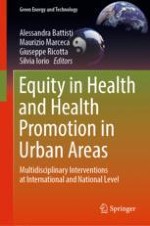The book explores approaches, methods and best practices related to health promotion in urban areas. Thanks to the increasingly tight connection among urbanism, architecture, bioethics, anthropology, sociology and medicine, we are now reaching an “ecological” health perspective. This new viewpoint has pushed the study of social health determinants and their unequal distribution in the population, resulting in the study of the generation of structurally-determined differences in health and healthcare. There is the need to make use of a unitary framework in order to understand the intertwining of multidimensional dynamics that define the urban context and the need to disseminate, enhance, and improve existing interventions in the field. This volume consequently results in the discussion and comparison of contents and methods to be implemented in multidisciplinary interventions related to the promotion of community-based healthcare and health in the urban setting.
The book represents a useful opportunity for scientific growth and international sharing of methodologies that can help develop a common language and approach to be shared across different academic spheres. This is not only an exchange of knowledge among different fields of study, but also the creation of foundations for creating an increasingly complex network of scientific culture and operational collaborations to transfer knowledge and attract academic and public attention, influencing decision-makers and gaining advocacy accordingly.
